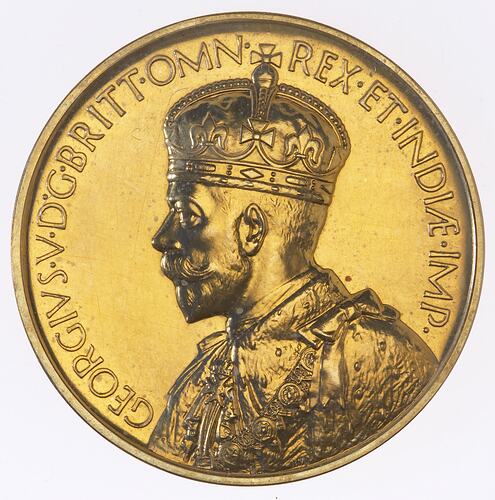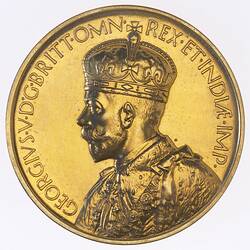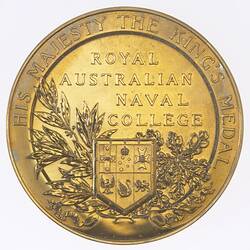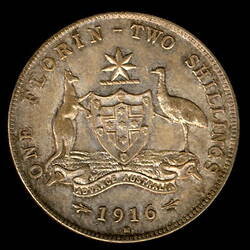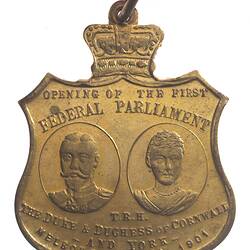Summary
Australia
Medal - Royal Australian Naval College His Majesty the King's c. 1920( AD)
Mint: Royal Mint, London
Other Details: This medal features a crowned portrait of King George V, who reigned from 1910 until 1936, by the Melbourne-born artist Sir Edgar Bertram MacKennal. In 1912 the Royal Australian Naval College was established, just prior to the 1913 entry of the first Australian Fleet into Sydney harbour. Formal control of these units now passed from the British Government to the Commonwealth Naval Board. Captain Joseph Burnett was one of the original intake, starting his tutilage on 31 December 1912. In 1915 the College was moved to Jervis Bay, on the NSW south coast. In the early thirties, lack of funds forced many economies in naval activity. These economies included the transfer of the Naval College from Jervis Bay to Flinders Naval Depot in Victoria. Students who excelled at the College were recognized through the award of medals. In 1932 Buster Crabb (later Rear Admiral Buster Crabb, Fleet Commander) entered the Royal Australian Naval College at Flinders, where he excelled. He became chief cadet captain, gained his colours in rugby, hockey and tennis, and was awarded the King's Medal on passing out in 1935.
Physical Description
A gilt bronze medal (44 mm. diameter) featuring a crowned bust of King George V
Obverse Description
Crowned bust of George V; around, GEORGIVS.V.D:G.BRITT.OMN.REX.ET.INDIAE.IMP.
Reverse Description
Around on broad rim, HIS MAJESTY THE KING'S MEDAL within, above a shield depicting the six States set against a background of olive and oak leaves ROYAL / AUSTRALIAN / NAVAL / COLLEGE
Edge Description
stamped SPECIMEN GILT SPECIMEN GILT
Significance
This medal features a crowned portrait of King George V, who reigned from 1910 until 1936, by the Melbourne-born artist Sir Edgar Bertram MacKennal. In 1912 the Royal Australian Naval College was established, just prior to the 1913 entry of the first Australian Fleet into Sydney harbour. Formal control of these units now passed from the British Government to the Commonwealth Naval Board. Captain Joseph Burnett was one of the original intake, starting his tutilage on 31 December 1912. In 1915 the College was moved to Jervis Bay, on the NSW south coast. In the early thirties, lack of funds forced many economies in naval activity. These economies included the transfer of the Naval College from Jervis Bay to Flinders Naval Depot in Victoria. Students who excelled at the College were recognized through the award of medals. In 1932 Buster Crabb (later Rear Admiral Buster Crabb, Fleet Commander) entered the Royal Australian Naval College at Flinders, where he excelled. He became chief cadet captain, gained his colours in rugby, hockey and tennis, and was awarded the King's Medal on passing out in 1935. -Australian Navy web site http://www.navy.gov.au/spc/history/general/briefhistory.htm; Australian War Memorial web site http://www.awm.gov.au/encyclopedia/hmas_sydney/burnett.htm; Defence Jobs web site http://www.defencejobs.gov.au/careers_explorer/Navy288.html#PhysicalReq; Fairfax Network Obituaries Rear Admiral Buster Crabb, Fleet Commander, 1917-2001. -D. Tout-Smith 24/11/2003.
More Information
-
Collecting Areas
-
Acquisition Information
Transfer from Melbourne Branch of Royal Mint, 1978
-
Date Issued
circa 1930 AD
-
Issued By
-
Artist
-
Person Depicted
-
Inscriptions
Obverse: GEORGIVS.V.D:G.BRITT.OMN.REX.ET.INDIAE.IMP. Reverse ROYAL AUSTRALIAN NAVAL COLLEGE HIS MAJESTY THE KING'S MEDAL Edge: stamped SPECIMEN GILT SPECIMEN GILT
-
Series
-
Material
Gilt
-
Axis
12
-
Classification
-
Category
-
Discipline
-
Type of item
-
Dimensions
45 mm (Outside Diameter), 36.53 g (Weight)
-
Shape
Round
-
Keywords
